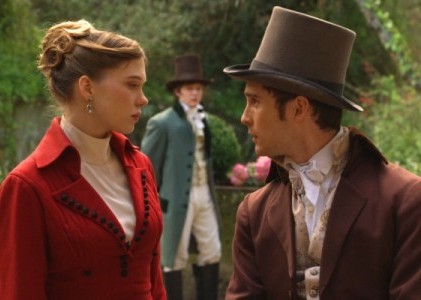Moments of 2011, Part 1
Continuing our annual tradition, we invited some of our regular contributors and colleagues, as well as a few writers and artists, to select their moving image moment or event of 2011—anything from an entire movie or TV series to an individual scene or shot, from a retrospective or exhibition to a news story or viral video. Part 1 follows; Part 2 of the survey can be found here.
Girish Shambu, blogger and co-editor of LOLA
There is an astounding pedagogical moment in This Is Not a Film (Jafar Panahi/Mojtaba Mirtahmasb) that encapsulates an entire philosophy of cinema. Forbidden from making a film by the authorities, Panahi sets out to enact a scene from his screenplay. He marks off on his carpet a space that stands in for a room in the script. He describes the characters and the situation—and starts to act out the scene. But mid-gesture, he freezes and falls silent, unable to continue. We see the hint of a tear in his eye. Before he utters a word, we can sense what he is thinking: This Is Not a Film. It is a screenplay acted out, but it is not a film. We wonder: "What, then, is a film?" Perhaps the absence we encounter at that moment can simply be called...mise-en-scène.
I confess to being almost totally ignorant of Béla Tarr's previous work. His latest and presumably last film, The Turin Horse, is unlike anything I've seen. It's inspired by a perhaps apocryphal anecdote about Nietzsche's madness, which, they say, was precipitated when he saw a cab driver in Turin beating his horse. Words fail me when I try to describe it or say what it means. An unrelenting picture of harsh, impoverished isolation, it ought to be unbearable. I found it mesmerizing, poetic, and in a philosophical sense almost comic. Nothing much happens, although the camera is always in articulate motion. At the end, a well runs dry and the chief characters (a horse-drawn-cab driver and his daughter) decide to leave their dilapidated hut in the countryside and travel elsewhere. They take their horse and go off over a hill. After a while we see them coming back, returning to nothingness. It's like Beckett in reverse: I'll go on. I can't go on.
Andréa Picard, programmer and writer
Two films: Béla Tarr's The Turin Horse and Jafar Panahi's This Is Not a Film. Two unspeakably beautiful films fueled by a soul of resistance, nagging eschatological trajectories, both born out of brute barbarous repression; two instant landmarks of our time. Transcendent in their quotidian gestures—which wrestle with life and death simultaneously in every breath while striving to survive both physically and mentally—the confinement and prison-like existences depicted in the films define an age of repression and obscene cultural conservatism that we are too eager to ignore. In the face of political oppression or bland, boorish, and marketing-driven desecration, we've thankfully seen cinema triumph as personal and collective expressions of resistance to match the year's numerous uprisings across the globe. What these two works made clear is an encroaching global regression where whipping winds and masking tape can detain, but which also give shape to a desire so great that we can sense and relish the power of art not only to inspire but also to destabilize a world much in need of a shake-up.
As Christopher Hitchens was known to say: "In the hate column: dictatorship, religion, stupidity, demagogy, censorship, bullying and intimidation. In the love column: literature, irony, humor, the individual and the defense of free expression." To which I'll add extraordinary works of cinema. Now, where would we be if Nietzsche had encountered an iguana in Torino instead of a horse?
One exhibition: Cyprien Gaillard, Marcel Duchamp Prize 2010, Centre Pompidou. Already enduring a catty backlash to his venerable prize-winning with accusations of academism (a French national pastime), 31-year-old Cyprien Gaillard's Duchamp prize exhibition at Beaubourg offered many pretty pictures (846 Polaroids to be exact, taken on the diagonal and shaped into groups of nine forming diamonds) and much to think about. With his Diderot-inspired gallivanting across the globe from 2006-11, pilgrimages involving Henry Purcell and Hubert Robert, while mining Land Art terrain and the discourse of colonial museumification, Gaillard's Geographical Analogies amount to an astonishing encyclopedia of ruins, ancient and contemporary. Heady and handsome, especially for those with a vitrine fetish.
Tom McCormack, critic
Like most people I know, I spent a lot of the last year transfixed by the waves of political revolt that spread from the Middle East to Europe to the U.S., and I watched somewhat dumbstruck as online distribution channels perfected for the spread of prank videos, self-absorbed confessionals, and celebrity gossip were turned on an instant to the purpose of perpetuating civil disobedience and documenting state violence. Twitter and UStream became the best sources for news; pepper-spray cop became the year’s biggest meme. Forty-eight years after Abraham Zapruder captured the JFK assassination on Super-8, citizen journalism came of age.
The single moment to which I found myself returning most often occurs in a video of the pepper-spraying at UC Davis. The woman yelling off-camera at around 6:57: the grain of her voice, the simplicity and completeness of her conviction, her exactitude. This was America in 2011.
Genevieve Yue, scholar and critic
Following the pepper-spraying of Occupy demonstrators by campus police, as well as the eviction of their encampment, calls immediately sounded for the resignation of UC Davis chancellor Linda Katehi. The chancellor defended her leadership at a press conference the following day, but when she stepped outside she was met with a group of silent protesters. Amid a stream of camera clicks and flashes, she slowly walked the student-lined path to her car. What's striking about this video is its starkness: the deliberate cadence of Katehi's heels, a bright light washing out her solemn face, rows of seated figures extending into the darkness. This is protest as learned from the closing scene of The Birds and here, like Hitchcock's chilly avian escorts, the mute bodies of the protesters give way to a uniform stare. Though she tells a reporter she doesn't feel threatened, Katehi has trouble meeting anyone's eyes.
Jason Eppink, assistant curator of digital media, Museum of the Moving Image
2011 is the year live streaming came of age. The right conditions have existed for a year or two, but the galvanizing event that birthed a hundred citizen journalists was the Occupy Wall Street movement protesting the excessive power of banks and their role in corrupting democratic processes and widening economic inequality.
The Media Establishment's appointed celebrity is Tim Pool, the excitable narrator at The Other 99 whose charming, durational reporting has earned him their adoration. And to be sure, he's great: a model of transparency and fairness. But the larger story is the dozens (hundreds?) of activists around the USA who have lent their smart phones and data plans to the cause, in concert with volunteer media teams holed up in apartments to shape the onslaught of images into something watchable.
Of course kids with their smart phones don't compare to the high production values and polish of the corporate media product, and that's much of the appeal in an age of increased media literacy and skepticism about what these institutions aren't reporting, by choice or by force. When wearing a press pass is grounds for removal by law enforcement from a press-worthy event, those with no regard for legacy institutions are the people capturing and distributing newsworthy images for the rest of us.
Runner Up, still #OWS: The 99% "Bat Signal" on the Verizon Building. The reveal was electric, and its backstory is heartwarming.
Jeff Reichert, filmmaker and co-editor of Reverse Shot
At the midway point of Mysteries of Lisbon, I wasn't quite sure what the audience was making of Raúl Ruiz's epic meditation on the powers of storytelling. Were they enjoying the endless detours-into-detours that made the present tense of the film seem to freeze in time, or were they bored stiff and wishing he'd just get on with it already? We all shuffled into the theater after the intermission and within minutes of the lights going dark, one character sat another down and said, "Let me tell you a story." The crowd erupted in peals of laughter, and I knew Ruiz had won the day.
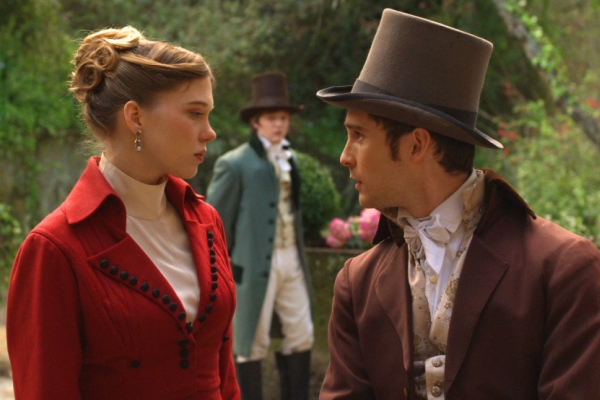
Léa Seydoux in Mysteries of Lisbon
David Sterritt, film critic, Tikkun
It has been another fine year for writer-directors making their first theatrical features. Sean Durkin's remarkable Martha Marcy May Marlene introduces a strikingly original talent who's willing to take considerable artistic risks in the service of bravely dark material. Ditto for Julia Leigh, whose Sleeping Beauty is a genuinely haunting experience, and J.C. Chandor presents an anti-Capra capitalism in which everyone finds a reason to sell out, just like real life! Cinema is nowhere near dead with gifted newcomers like these arriving on the scene.
Saul Austerlitz, critic
A woman reaches into her purse and passes a gift behind her back to her husband, so he can give her daughter her Christmas present. This moment of silent communication between Paul (Mimi Branescu) and Adriana (Mirela Oprisor), coming in the final scene of Radu Muntean's Tuesday, After Christmas, is the very last second of unthinking marital intimacy between a couple about to part ways permanently. It is also, in its carefully understated, Romanian way, truly heartbreaking.
David Hudson, Mubi's Daily Notebook
Back in February, some felt that the Berlinale jury went a little overboard in awarding Asghar Farhadi's A Separation not only the Golden Bear but also both Silver Bears for Acting to the male and female ensembles. I'd have welcomed gold for Béla Tarr's The Turin Horse, but I share the jury's enthusiasm for Farhadi's actors—in particular for Shahab Hosseini. As Hodjat, whose pregnant wife has taken on part-time work behind his back, he gave me some of the most electric jolts I felt in a movie theater all year: abrupt yet intensely complex bursts of hurt and anger, immediately suppressed, sometimes successfully, sometimes not. These moments when the rage over a perceived injustice, a challenge to his honor flares up in his eyes—and there are more than a few—are given depth and texture by a simultaneous awareness (which Hosseini somehow makes visible) that the deck is stacked against him, that any effort to right a wrong will only feed the wrong. Which in turn, of course, feeds his fury all the more. I'm sorry to see in Hosseini's Wikipedia entry that he plans to take a break from acting in films, but I look forward to his return in 2015.
Kelly Reichardt, filmmaker
I was in L.A. last month and my friend Wash tried to get me to watch the Iranian film A Separation
on DVD on his laptop. Blah! I had no intention of watching a movie with
subtitles on a laptop. For some reason we couldn't get the disc to play
on his TV and Wash was really persistent so I agreed to watch five
minutes just to shut him up. I somehow got sucked in right away and when
our other friend Richard showed up and joined us on the couch the three
of us sat there silent hunched over the laptop for the next two hours.
I'm super excited to see A Separation on the screen. Best retro
experience was The Life and Death of Colonel Blimp. I liked the doc If a Tree Falls, and such great footage in The Black Power Mixtape, which I saw at the lovely Cinema 21 in Portland. (The ultra radical and super political black film of the year is of course The Help.) I loved Mildred Pierce when it aired and was fortunate enough to see it projected at the Ziegfeld. I got really sucked into Mike White's Enlightened on HBO. And the Occupy Wall Street "bat-signal" projections during the Brooklyn Bridge #N17 march was pretty amazing. The Sunday evening radio show Nighttime Whispers
with Tanya Smith on the online station House of Sound has been a
favorite this year. Most exciting live music for me was the reunion of
Pussy Galore on the fourth night of the annual Yo La Tengo Hanukkah
shows at Maxwell's. Favorite read this past year was the soon to be
released Jon Raymond novel Rain Dragon and the best discoveries were the
books of Oregon writer Don Carpenter.
Jem Cohen, filmmaker
A quandary: I keep telling people they must see Le Quattro Volte, but then I tell them they simply can't see it on DVD or, even worse, on a laptop. I'm not being precious or old-fashioned; it's just that some of the most vital scenes in this vital film play out via tiny, tiny figures in the farthest distance. Seen too small they might not be seen at all. Furthermore, the film's intimate embrace of time, unfolding in front of us in microcosm, unfolding around us in widest macro, would likely be bludgeoned by the small screen, where cinematic patience is so cruelly tested and so often defeated.
One of the running jokes of the film (and though resolutely calm and fiercely unsentimental, it is funny as hell) involves ants. Seen properly on a big screen, the ants and all ant-like creatures, humans included, are carefully allowed to play out their ancient fates in ways entirely down-to-earth and entirely magnificent. I loved this film and like few others I've seen recently it brought home the full power, and occasional necessity, of the theatrical cinematic experience. I only hope programmers and theater owners bring it back to the big screen whenever possible.
Noah Isenberg, director of Screen Studies, The New School
On a very hot New York evening this past July, I found myself seeking refuge in an air-conditioned screening room at the Angelika. The film that was playing was David Robert Mitchell's debut feature, The Myth of the American Sleepover, a quiet little picture with an unusually large ensemble cast of young amateur actors. Set in suburban Michigan in the final days of summer, with several circles of teenagers anticipating the inevitable end of vacation, it evokes the kind of angst and awkwardness we know well from the movies of John Hughes, Richard Linklater, and others. But what distinguishes Mitchell's film—in addition to some of its compositional flair and continental pacing—is the impressive range of performances he teases out of his actors, notably Claire Sloma, whose sprightly manner and pixie looks recall the young Jean Seberg. Not a bad way to cool off.
Annette Insdorf, director of undergraduate film studies, Columbia University
Both John Turturro's Passione and Wim Wenders's Pina: by the end of these musical journeys, I felt exhilarated. Inventively and affectionately, they capture the art of a unique place (Naples' songs) or personality (Pina Bausch's dances). There was a special thrill seeing Pina in 3D at the Telluride Film Festival's "Galaxy," a school gym magically transformed into a state-of-the-art theater every Labor Day weekend.
Aaron Katz, filmmaker
I love The Trip and, in my opinion, even the Extreme Measures deleted scene on its own would be the funniest movie of the year.
Rachael Rakes, assistant curator of film, Museum of the Moving Image
The expanded sound-image installation, Ryoji Ikeda's the transfinite, towered but managed to feign interactivity. There was a palpable glee resulting from the removal of shoes. People danced around in it in the semi-darkness, slid, napped, got up close. We tried out different moves and points of entry, feeling nice about the smoothness and pliancy, considering it possible to get sucked into the fuzz lines and disappear. And then walking around to the backside we found there was something more serious going on: number wires, sound code, military, math.

the transfinite
Thomas Doherty, professor of American Studies, Brandeis University
"Face Off," the double-edged title of the fourth season finale of the meth-fueled AMC series Breaking Bad, featured the blistering climax of a multi-arc-long mano a mano death mach between high school chem teacher gone bad Walter White (Bryan Cranston), and his murderous archrival, the dapper drug lord Gus Fring (played with precision-point targeting by the brilliant Giancarlo Esposito). Walt has arranged a suicide bombing, not his, a scheme that goes off without a hitch. An exterior shot of a hospital room shows the moment of detonation: a huge explosion that blows the door off its hinges. Gus slowly walks out of the room and you think no way he could have survived that explosion, what a cheat, the show didn't have the guts to whack its most magnetic villain and force majeure. True to form, Gus, though a little wobbly, begins to put himself back together—fixing his tie, the gesture that has been the familiar sign of his control-freak persona. Taking its time, the camera pivots around to reveal the other side of his face, which is not there: an empty eye socket, a mass of pulp, the skull fully visible, a vision out of EC Comics. It was not just a stunning "gotcha!" moment, but an exposure of the bloody monster behind the veneer of the squeaky clean businessman.
Dan Streible, professor of cinema studies at NYU and director of the Orphan Film Symposium
The final shot and the very last minutes of the Season 6 finale of the Showtime series Dexter contained dynamic plot twists, daring subject matter, and remarkable performances. [Total spoiler alert necessary!] For six years, actor Michael C. Hall has portrayed now-beloved vigilante revenge serial killer Dexter Morgan, with an affectless physiognomy and hilarious voice-over narration. Dexter's nemeses have come and gone, but his best friend remains his adoptive sister, Debra Morgan, played by Jennifer Carpenter. During the run of the series, Hall and Carpenter have gone from being fellow cast members to a married couple and now to exes.
This season, the Dexter writers decided to "go there." Sister Deb admits that she is in love with brother Dexter, and tearfully decides it's okay, because they are not biologically related. She confesses her love to Dexter and is happy. Moments later we see Dex perform his ritualized execution of "the Doomsday killer" (played by Colin Hanks), in a church no less. Just as his knife plunges into his deserving victim's chest, Debra enters. Their eyes meet. The end. Thus Debra Morgan of Miami Metro Homicide has in a matter of minutes gone from being an ecstatic incest celebrant to a witness traumatized by the revelation that her brother-lover is possessed by a spectacular bloodlust.
There's a whole lotta writing to be done to imagine the start of Season 7 of Dexter.
Michael Koresky, writer and editor, The Criterion Collection and Reverse Shot
In recent years, common pop-cultural wisdom's held that mainstream American television has overtaken mainstream American cinema in terms of daring and quality. (Such comparison games are fruitless, but the sentiment was at least understandable when we had The Sopranos, The Wire, and Mad Men at their peaks.) So when Todd Haynes turned to television, it may have seemed a capitulation at first. But his extraordinary Mildred Pierce wasn't Haynes doing TV so much as a very savvy way of getting classical American filmmaking back into the discussion by bringing it where people were actually still watching. With its profoundly protracted storytelling (stretched over 336 compelling minutes), exquisite performances (am I the only one who didn't know Mare Winningham had that in her?), and brainy but accessible visual approach (Ed Lachman shot a Depression-era melodrama as though seen through a 1970s movie filter), Mildred Pierce might have been on television, but this was surely cinema—made grand not through flourish but through Haynes's unerring, humane attention to every glimmer on every actor's face. Television. Movies. Whatever. Who needs such definitions in the face of something like Mildred Pierce?
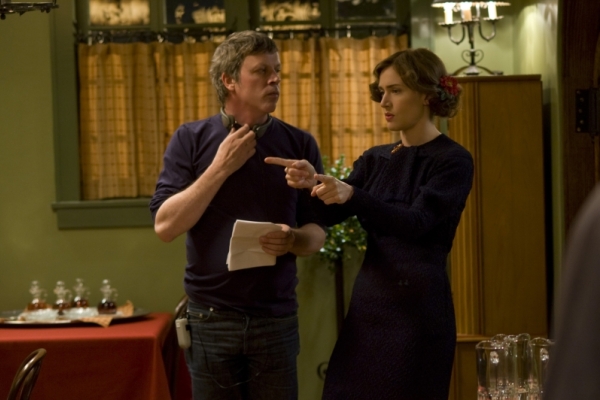
Todd Haynes and Kate Winslet on the set of Mildred Pierce
Nellie Killian, co-director of Migrating Forms festival
The Complete Minnelli at BAM: This series completely dominated my fall. The movies I knew were even better than I remembered and the ones I'd never seen blew my mind.
Also, under the wire: Amy Sillman's beautiful George Kuchar–inspired cover art for the new Anthology Film Archives calendar.
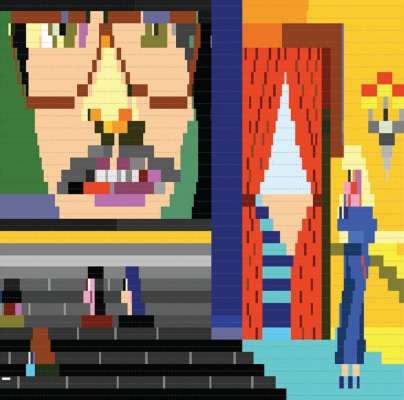
Anthology Film Archives calendar cover artwork by Amy Sillman
Jonathan Rosenbaum, critic
Now that I'm no longer a regular film reviewer, I've been encountering some logistical problems in responding to various end-of-the-year polls, which often require me to know and even master various arcane details about New York premieres, what constitutes a commercial run, what films have acquired distributors but haven't yet opened, etc. All of which has led to me overlooking strong candidates for my 10 or 20-best lists—something that was already a danger during my 20 years at the Chicago Reader due to the fact that one usually has far better luck remembering end-of-the-year releases.
The most conspicuous casualty of this handicap in 2011 has been Azazel Jacobs and Patrick Dewitt's weird and wonderful and highly original Terri, a revelation for me that both confirmed and went beyond the promises offered by Jacobs's The GoodTimesKid (2005) and Momma's Man (2008), but which I somehow neglected to include on my top-20 list for Film Comment. Another 2011 revelation, even stronger, was Lee Chang-dong's Poetry, one of the very first South Korean films I've ever flipped over, much less liked, which most of my festival-going colleagues saw in 2010. But conversely, I still haven't been able to catch up with Jafar Panahi's This Is Not a Film, and considering my admiration for his previous features, I suspect this would have made it onto my lists if I'd found some way of seeing it.
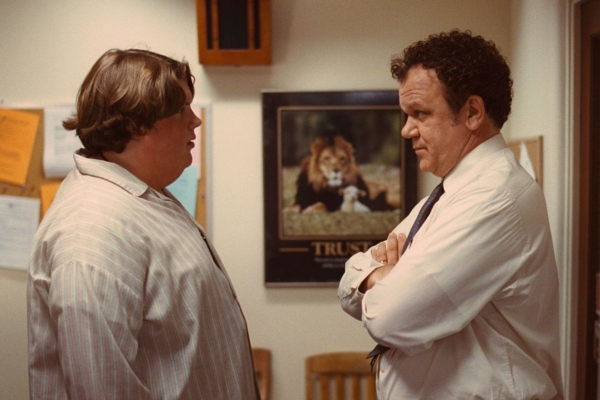
Jacob Wysocki and John C. Reilly in Terri
Chris Wisniewski, deputy director for education, Museum of the Moving Image
Too often, these year-end recaps serve as an occasion to bemoan yet
another lousy year of movies and moviegoing. But 2011 was something
special, filled with incredible moments from the art house (I think of
Elizabeth Olsen being driven to a destination unknown in Martha Marcy May Marlene and Take Shelter's Michael Shannon mustering the courage to open the door to his fallout shelter, not to mention Poetry, Mysteries of Lisbon,
and Nicolae Ceausescu cheating at volleyball) to the multiplex (cheers
to you, Maya Rudolph, for your food-poisoning-induced diarrhea in Bridesmaids) to repertory films (thank you, Brooklyn Academy of Music, for the chance to see The Bad and the Beautiful, The Cobweb, and The Long, Long Trailer for the first time in that complete Minnelli retrospective).
In
contemplating the moving images that meant the most to me this year, I
mined these examples, trying to find a "moment" for this assignment that
wasn't from Terrence Malick's The Tree of Life. It seemed too
obvious, almost cliché. As I searched desperately for alternatives—and
came up with many that were worthy—I realized that I was never more
moved, astonished, or alive to the possibilities of the medium as I was
during the sequence in that film during which Jack grows from infancy to
adolescence. When I first saw the scene in which he, as a toddler, eyes
his newborn brother on the lawn with equal parts curiosity and
circumspection, I remember thinking, "How did Malick get this
performance out of a toddler?" With a little more distance, I realized
that in the case of someone like Malick, one shouldn't bother with the
"how" and just accept moments like these as the gifts they are.
Richard Koszarski, film historian and professor of English at Rutgers University
I would nominate the restoration this year of the hand-colored version of Georges Méliès's A Trip to the Moon, rolled out to great acclaim at various festivals, from Cannes to Bologna Cinema Ritrovato to Pordenone to NYFF (that, in itself, is some kind of accomplishment). I saw it at Bologna, where it was screened twice—once with the AIR score, and again with a wonderful adaptation, by Timothy Brock, of the original Jacques Offenbach Le Voyage dans la Lune score. Viewers are advised to hold out for the Offenbach.
David Phelps, editor at La Furia Umana
News from the Night—Bahrain: not one image, but two or more, each mirroring the other. Reality and fantasy, the body and the mind, as in Farocki's Serious Games, Labarthe's No Comment, Hellman's Road to Nowhere, Ferrara's 4:44, Godard's Film Socialisme, characters watch simulations of reality, one fantastical image staring down another, with one's own, personally-controlled-and-curated cinema on every computer screen (write an idea in the Google searchbox, see it performed in three tabs, then cut between them for montage). One image: even better than the sword-and-sandal epics of the '60s, the grave, deadlocked iconography of 2011 Hollywood has continuously managed to turn childhood fantasies into prestigious abstractions—no characters, only symbols manufactured by their own plots. But another image, another plot: that while CGI's self-contained dreamworlds make a plastic barrier against cultural revolutions, reality becomes staged in video games and on YouTube by the American military, Occupy protesters, and teenagers vlogging their mornings. The mystery of the Hollywood abstractions, the characters suspended in their own bad dreams—Hugo and J. Edgar as much as the Transformers seem programmers programmed to do what they do—get upended by the mystery of abstractions in Bahrain night footage, which at least refers to something outside of itself. Even while any understanding of who's on what side, what the sounds signify (tear gas canisters, shots?), what the images signify (black and fog—tear gas?), what's going on, is obscured by the clip's own devices, the inferences to be drawn insist on some imagination to see behind the image, the insinuating clouds, to a reality underneath. Of course—as in Hellman, as in Ferrara, as in Godard—it's a reality to be propagated across the net and to rupture one's own only on a bedroom computer screen, one of a million tabs one could have opened onto the world.
Gabe Klinger, writer, curator, and teacher
The first time I saw Emmanuelle Demoris's Mafrouza—a five-part documentary about the working poor residents of the no-longer-extant neighborhood of the title in Alexandria, Egypt—was from a DVD in my apartment in Chicago. It was early fall, 2010, and the film had just recently premiered at the Locarno Film Festival, where its fifth episode, "Paraboles (The Art of Speaking)," earned an award and plaudits from a handful of critics. A couple of weeks earlier I had cold-emailed Demoris asking to see the entire series. "We sent you the films," she replied almost overnight, and not a full week went by and a batch of DVDs from the Paris production company founded by her producing partner Jean Gruault (a scenarist for the likes of Rossellini, Truffaut, Resnais, and others) arrived in the mail.
I had never seen a documentary about Egypt's impoverished communities (I later learned that Mubarak's regime had expressly forbidden filming certain sectors of society), and I sat riveted by the people of Mafrouza as I imagined Demoris had been when she first encountered them on a trip to Alexandria accompanying a group of French archeologists over a decade ago. Watching all 12 hours of the film, it never occurred to me for a moment that I would, a few short months later, travel to post-Arab Spring Egypt to present Mafrouza alongside its author.
Demoris had begun making plans to show the film in Egypt before the protests in January and asked if I wanted to cover the screenings as a journalist. By the time of Mubarak's resignation and the dissolution of the Egyptian parliament, screening plans were suspended. But by March, Demoris was told things would proceed more or less as planned and asked again if I would go. I immediately booked a ticket. Waking up in Alexandria to the morning prayer call that makes up such a vivid part of Mafrouza's soundscape, I felt as if I had stepped out of my life and into Demoris's film. Over the course of my weeklong trip to Egypt I began to witness a local audience, politically uprooted, absorb Mafrouza as an essential element in their reawakening. From Locarno to my living room in Chicago to the barbed-wire-lined streets of Alexandria, Mafrouza seemed to have found its moment—and this observer his.
Mark Peranson, editor of Cinema Scope
The unsung genre of recording family milestones—weddings, bar mitzvahs, communions, etc.—stands outside the traditional realms of filmmaking and film criticism. With its neutral perspective, the goal is to provide an accurate, truthful representation of the ceremonies, traditions, rituals, as they exist for the record, to be looked back upon later in life when memory may have faded, as a remembrance of a time when families put aside all differences for the sake of celebration. Such an invisible filmmaker should let what’s in front of the camera, not who’s behind it, drive the narrative. (The same holds true for TV procedurals or sitcoms.) Yet this invisibility on the part of the family “filmmaker” (or perhaps “documenter”) is not an easy skill to master, nor is it often praised. But I would like to praise one such anonymous hero, as well as the documentary in which his work is placed as a coda.
The main material of Gastón Solnicki’s Papirosen consists of what the filmmaker, over 10 years, filmed of his family from his point of view. Interspersed with scenes of the sort that Gastón’s mother has forbidden him to show the film in their native Argentina is older home-movie footage. The authors are unknown (to the audience), but we can assume they are members of Solnicki’s family, shooting from the perspective of happiness and relief of arriving in Argentina, a new life ahead, escaping the horrors of WWII. By and large, they seem to project happiness, but as we learn from Solnicki’s narrative, such happiness is often a shell to cover more serious issues, like the suicide of his father’s father.
The last use of archival footage in the film is an absolute killer, and may even be an example of pure cinema. Again, the filmmaker is unknown—perhaps it’s a member of Solnicki’s family, but it’s just as likely a job for hire, and comprises no direct point of view, though it seems to be an attempt at some kind of merging between the bar mitzvah and music-video genres. It’s the mid-‘80s. The cameraman is standing on a stage, in the midst of the band and singers, shooting the mass movements of the early-teenage line-dancing celebrants, who are being led in the steps to this Israeli dance by full-body disco-suit-wearing hired professionals, part of the same onstage crew. The music and the long take of movement are infectious, even if we’re aware that essentially we’re being presented propaganda. (The scene is intercut with the film’s closing credits, names that represent a second family to Solnicki.)
On its own, this dance is fine enough—all good films have dance numbers. But in the context of the full film, and the particular scene that precedes it, the bar mitzvah footage is heightened to the level of cinema. It’s an example of the consummate editing by Solnicki and Andrea Kleinman that we’ve seen throughout the film: the bar mitzvah is preceded by Gastón’s father Victor and his grandson, Mateo, on the ski lifts, where we found them at the beginning of the film, though now it’s reveled that it’s Rosh Hashanah, the Jewish New Year, and Victor is singing "Avenu Malkenu" (“Our Father, Our King”) to Mateo, as Victor’s own father used to sing it. Mateo then asks how Victor’s father died, and Victor replies, “From sadness.” Solnicki then cuts to the bar mitzvah of his brother Alan, whom we see little of in the film because he’s decided to opt out of his family duties. This is the only scene of a family gathering that doesn’t include some kind of argument, dispute, or passive-aggressive behaviour; the Solnickis are in the background, hidden in the middle of the dancers, or off-screen all together. Appreciate the happy moments, Solnicki the editor says, making fair use of this anonymous videographer, for they might come once every 13 years. I readily admit that despite my abhorrence of bar mitzvahs, the scene chokes me up each time I watch it. ![]()
LATEST ARTICLES
-20140814-173707-thumb3.jpg)
Fighting Words
by Imogen Sara Smith
posted August 12, 2014

Fighting Words, Part 2
by Imogen Sara Smith
posted August 20, 2014

On the Margins: The Fil…
by Andrew Chan
posted August 12, 2014

Robin Williams: A Sense…
by David Schwartz
posted August 12, 2014
 Moments of 2011, Part 1
Moments of 2011, Part 1
KEYWORDS
This Is Not a Film | The Turin Horse | political film | Mysteries of Lisbon | A Separation | independent cinema | experimental film | television | Vincente Minnelli | silent film | documentary | PapirosenRELATED ARTICLE
Moments of 2008, Part 1 by Various WritersMoments of 2008, Part 2 by Various Writers
Moments of 2009 by Various Writers
Moments of 2010 by Various Writers
Moments of 2011, Part 2 by Various Writers
Moments of 2012, Part 1 by Various Writers
Moments of 2012, Part 2 by Various Writers
More: Article Archive

